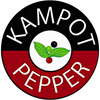As consumers, we stand at the very end of a long supply chain. We often do not have much chance to find out whether we are buying genuine quality, whether the people involved in the chain receive adequate compensation for their work, or whether the given product does not represent too great a burden on our planet.
Direct trade also guarantees a direct path of the raw material to you
In the case of Kampot pepper, at the other end of this chain, the leaves of the pepper vines gently rustle, cared for by the hands of local farmers. From them, the peppercorns have quite a journey to your table, but unlike peppers of other brands, we strive to have only one link in that chain, and that is us. Thanks to this, we are able to control the quality, give farmers adequate compensation, and at the same time bring fresh pepper of perfect taste to your table.
At least with Kampot pepper, thanks to all the mandatory certifications, there is one certainty – that this pepper is always hand-picked and inspected, sun-dried, and meets all organic standards, which are also checked by the EU. However, whether the reseller truly adheres to fair trade or direct trade policies is often a question that is unfortunately answered negatively, even through "certificates" that in countries with huge corruption often mean nothing without oversight from a higher authority.
Fortunately for us, there is the KPPA (Kampot Pepper Promotion Association), which monitors the production of Kampot pepper worldwide, and if you are serious and trade in genuine Kampot pepper, you belong under it. What the association unfortunately cannot arrange is the enforcement of fair prices for Kampot pepper by all its members – it can only recommend it. Therefore, it was a surprise for us that we were the first to voluntarily commit to adhering to this officially set fair price.
Other pepper than Kampot in the country has no organization that supervises its production, so it is quite clear that its trade is conducted in a "whatever anyone feels like" style.
Speed unfortunately often takes precedence over quality
Another problem arises during processing, which often takes place mechanically, and again the most important factors are time and money. The grains are not soaked or dried long enough, and the main goal of farm workers, who often belong to foreign traders, is to get the grains into bags as quickly as possible and earn their reward.
As a result, the grains are again exposed to unfavorable conditions, become musty, and develop pathogenic germs. Quality thus degrades again, and from that pleasant and characteristic pepper flavor, little remains.
The pepper then passes from hand to hand, from trader to trader, with each adding the price of their work. The grains can languish on ships for a whole year and no longer remember what it is like to bathe in the sun's rays. What reaches the consumer's table is stale, tasteless, and odorless. Hoping for a better taste experience, the consumer then adds it to food, only to experience pure disappointment.
So buy pepper that you really like, that is socially responsible, and where you can see the specific people, families, and team who take care of its sale not only in Cambodia but also here – in the Czech Republic.


























